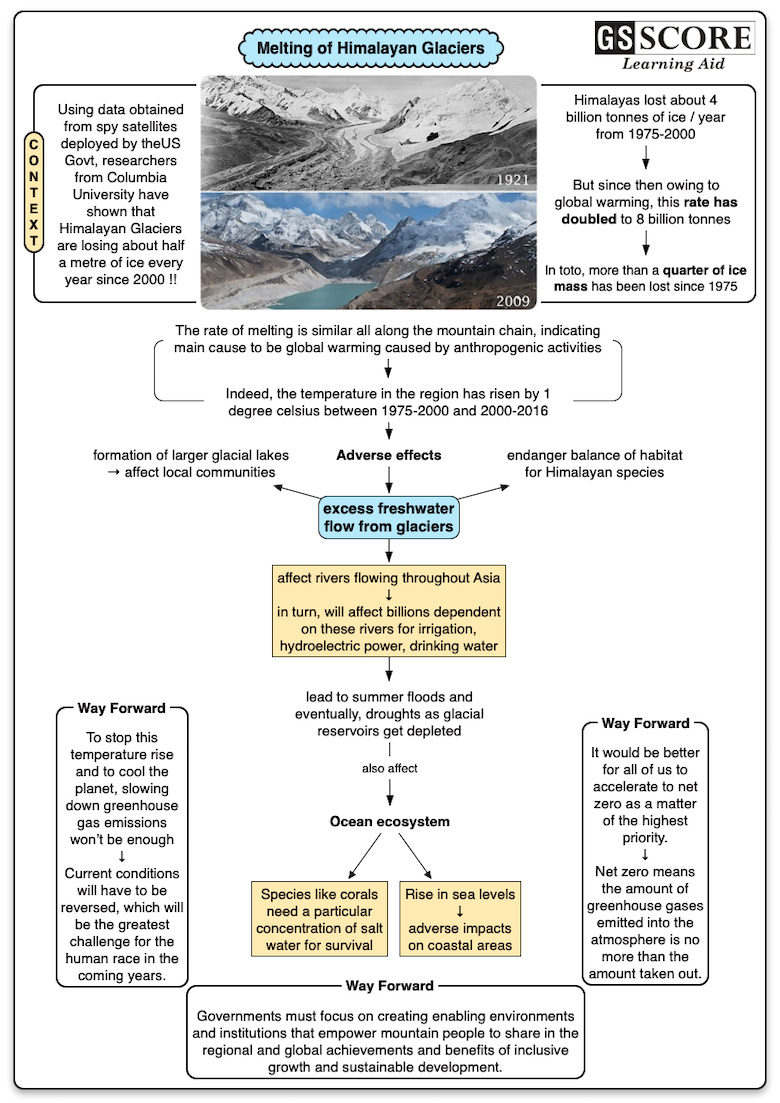

Researchers from Columbia University claimed that the Himalayan glaciers have lost more than a quarter of their ice in the last four decades.
Issue
Context:
Researchers from Columbia University claimed that the Himalayan glaciers have lost more than a quarter of their ice in the last four decades.
About:
Background
- The Hindu Kush-Himalayan (HKH) region extends over 2,000 km from east to west across the Asian continent spanning several countries: Afghanistan, Bangladesh, Bhutan, China, India, Nepal, and Pakistan.
- Hind Kush Himalayan region is also known as Third Pole due to its largest permanent snow covers after the North and South Poles — sustains the livelihoods of 240 million people living in the mountains and hills.
- This region is the source of numerous large Asian river systems, including the Indus, Ganges, and Brahmaputra, which provide water for over a billion people. The surface water of these rivers and associated groundwater constitute a significant strategic resource for all of Asia.
- Many of the countries in this region are already experiencing physical water scarcity. Existing water stress and projections of population growth have led to concern over possibilities of negative impacts from changes in the availability of water supplies in the coming decades.
- Climate change and global warming has emerged as threat to the Himalayan Ecosystem. Many researches in the recent past has claimed that the glaciers are melting at an accelerated pace. This could be detrimental in to the countries including India that are dependent on Himalayan Ecosystem for water and other geo-economicreasons.
Analysis
- Himalayan Assessment report of International Centre for Integrated Mountain Development (ICIMOD) says HKH region is warming faster than the global average. It would continue to warm through this century even if the world is able to limit global warming at the agreed 1.5 degrees Celsius.
- The per capita fossil fuel carbon dioxide emission from the HKH countries is one-sixth of the global average though it is disproportionately impacted.
- In the last 60 years, extreme cold events have become lesser while extreme warm weather events have become more pronounced. Both minimum and maximum temperatures are also changing: they are moving north, indicating overall warming.
- Every decade HKH loses one cold night and half a cold day. While warm nights have increased by 1.7 per decade, the region gets 1.2 warm days every decade.
- Alarmingly, changes in surface temperature (relative to 1976-2005) in this Himalayan region are higher than the global average, and even the South Asian region.
- The projected changes in the surface mean temperature over the HKH region are larger compared to the global mean change by the end of the 21st century.
- Although the climate of the region has changed significantly in the past, it is projected to change more dramatically in the near future.
- The number of glaciers in the Himalayan area has increased in the last five decades and this is an indicator of how severe glacier melting has been due to global warming.
- The increase in the number of glaciers is primarily due to glacier fragmentation — that big ones are splitting into smaller ones. And this is happening due to consistent loss in areas the glaciers occupy.
- Smaller glaciers are shrinking faster than larger ones, although the smaller glaciers of Ladakh show a lower rate of retreat than other Himalayan glaciers. However, the assessment makes clear that despite the surety of glaciers in the Hindu Kush Mountains losing length since 1973, no studies have been done to examine area change in this region.
Impact of melting Himalayan glaciers
- It has ramifications for the global climate. This region is a heat source in summer and a heat sink in winter.
- Along with the Tibetan Plateau, this influences the Indian summer monsoon. So, any changes in this region would have a bearing on the monsoon itself that already shows signs of changes in spread and distribution.
- It could trigger a multitude of biophysical and socio-economic impacts, such as biodiversity loss, increased glacial melting, and less predictable water availability—all of which will impact livelihoods and well-being in the HKH.
- Faster snow and glacier melting due to warming is already manifesting in formation of glacial lakes. Glacial lake outburst floods (GLOF) are becoming frequent and causing huge casualties and loss to local infrastructures.
- Glaciers in HKH have been retreating faster, and consistently causing greater water flows in rivers. In Tibetan Plateau, river run off has increased by 5.5 per cent.
- Most of the lakes in high altitudes have also reported water level rise by 0.2 m/year besides their surface areas expanding.
Way Forward
- To stop this temperature rise and to cool the planet, slowing down greenhouse gas emissions won’t be enough. Current conditions will have to reversed, which will be the greatest challenge for the human race in the coming years.
- Better for all of us to accelerate to net zero as a matter of the highest priority. Net zero means the amount of greenhouse gases emitted into the atmosphere is no more than the amount taken out.
- Governments must focus on creating enabling environments and institutions that empower mountain people to share in the regional and global achievements and benefits of inclusive growth and sustainable development.
|
Initiatives taken by India
|
Learning Aid
Practice Question:
The receding Himalayan glaciers underline the need for cooperation between countries that share Himalayas. Comment



